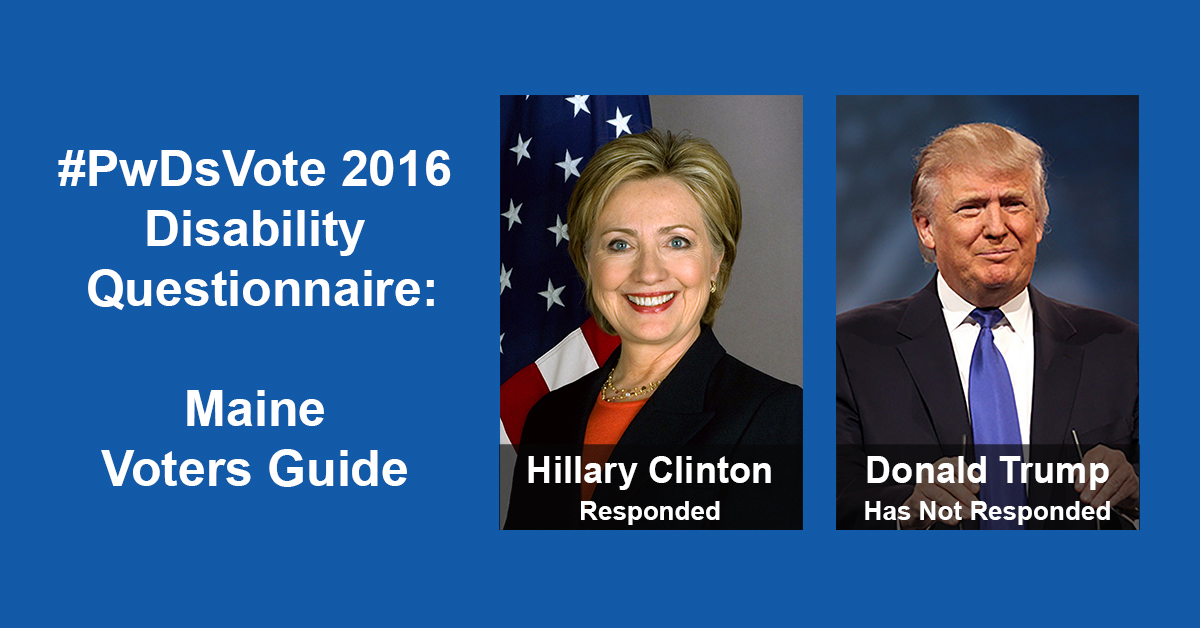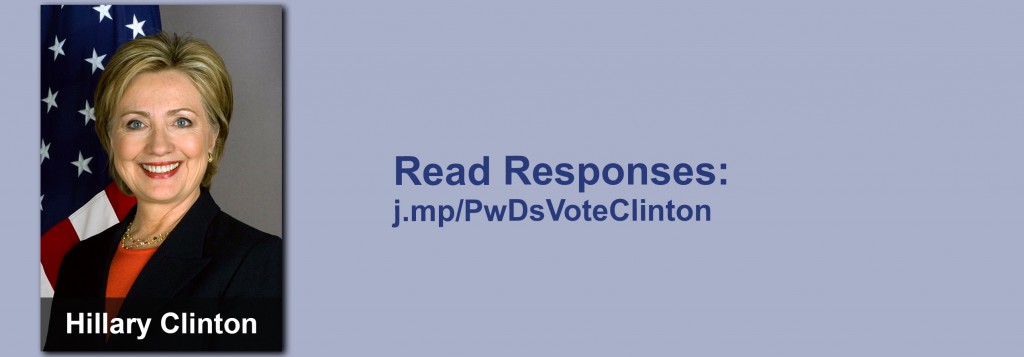Washington, Oct. 14 – As voters get ready to head to the polls in Maine, RespectAbility is releasing its Maine Disability Voter Guide for the upcoming presidential election. Democrat Hillary Clinton has completed the #PwDsVote Disability Campaign Questionnaire, but Republican Donald Trump has yet to do so.
The #PwDsVote 2016 Campaign Questionnaire was designed by and for people with disabilities (PwDs) and those who love them to know where candidates stand on key issues. RespectAbility is nonpartisan and does not endorse candidates. The questionnaire is purely for educational purposes as voters go to the polls.
According to a new report from Rutgers University, 35.4 million people with disabilities will be eligible to vote in the November 2016 elections, representing close to one-sixth of the total electorate. That’s an increase of nearly 11 percent since 2008.
The presidential questionnaire was created during the primary season and asked all of the presidential candidates to comment on 16 disability questions. Former Secretary of State Hillary Clinton responded by addressing all of the questions. Despite numerous requests in person and by phone and email, the Trump campaign has not yet filled out the questionnaire. The American Association of People with Disabilities and the National Council on Independent Living also has a nonpartisan presidential questionnaire, which both Clinton and Trump have completed. Libertarian Gary Johnson and Green Party candidate Jill Stein have not filled out either questionnaire.
Twenty-three candidates for Senate, as well as nine candidates for governor, from both sides of the aisle (19 Democrats, 13 Republicans) also completed the down ballot questionnaire, showing that disability rights is a nonpartisan issue. The responses also are geographically-diverse, coming from states all around the country, as politicians are paying more and more attention to the disability community.
Maine Needs to Improve Outcomes for Citizens with Disabilities
Maine can and must do better in terms of competitive, integrated employment for people with disabilities. Only 31.2 percent of the 117,607 working-age Mainers with disabilities are employed. Further, there are more than 9,300 youth with disabilities and each year a quarter of them will age out of school into an uncertain future. Maine’s voters are looking to know where the candidates stand on important disability issues in order to increase opportunities for competitive, integrated employment for people with disabilities and foster a more inclusive society. As such, RespectAbility has actively encouraged politicians to include issues facing people with disabilities in their policy agendas. Founded in 2013, RespectAbility is a nonpartisan, nonprofit organization working to end stigmas and advance opportunities for people with disabilities.
Maine has been viewed by some as a model state because it has Employment First policies enshrined both in executive order and in state legislation. However, when you look at the gap between the employment rate of people with disabilities and those without disabilities, Maine comes dead last in the country. Only 31.2 percent of people with disabilities in Maine are employed while 78.8 percent of those without disabilities are employed, which results in the 47.6-point gap.
Government action alone – through executive orders, legislative decisions, and regulatory oversight – is insufficient. The necessary condition for achieving greater competitive, integrated employment for individuals with disabilities is engaging employers, meeting their talent needs and addressing stigmas that are barriers to work.
In order to promote best practices and the inclusion of people with disabilities in state workforce systems, RespectAbility has submitted comments for all 50 state’s drafts of the Unified Plan, which is required under Section 102 of the Workforce Innovation and Opportunity Act (WIOA). This new law represents the intersection of hope and history for people with disabilities.
From the review of Maine’s Unified State Plan, it is clear that too many elements of the workforce system remain segmented and lack the lens of disability issues needed to better align programs. As Maine moves beyond the current draft of the Unified State Plan and looks to finalize WIOA implementation, there is a critical need to ensure the disability lens is applied to the work of the workforce system as a whole.
America has 1.2 million youth with disabilities, between the ages of 16 and 20. Each year 300,000 of them age into what should be the workforce, but stigmas and lack of knowledge about the capabilities of people with disabilities means that most do not find employers willing to hire them. Young adults with disabilities in all of these states are hoping to find work. They have high expectations and deserve the opportunity to achieve the American dream. Young people with disabilities may simply need some thoughtful help to transition into the workforce. See data on all 50 states here: State Data.
Fully one-out-of-five Americans have a disability, and 52 percent of likely voters have a loved one with a disability. Only 34 percent of working-age Americans with disabilities have jobs, despite the fact that the vast majority want to work. More than 11 million working age people with disabilities are now living on government benefits in our country.
RespectAbility President Jennifer Laszlo Mizrahi said, “Our community is looking for jobs so we can achieve the American dream, just like anyone else. It is vital for us to know where the candidates stand on economic, stigma, education, safety, transportation, housing, healthcare, foreign affairs and other issues.”
Remember to Vote
Maine residents can vote for the candidates of their choice either through the standard voting schedule or through early voting. If you would like to register to vote by mail or through a “voter registration drive,” the registration deadline is Oct. 18, 2016. However, you may register in person at your local town office, city hall, or other approved location at any time. For more information on registration: Maine Voter Registration.
While Maine does not have Early Voting in the sense of having certain polling places open on designated days prior to Election Day, Maine does have Absentee Voting both by mail and in person. To vote Absentee by mail, you must request a ballot by November 3, 2016, unless you have a specified excuse. You may vote in person, using an absentee ballot, at the municipal clerk’s office as soon as absentee ballots are available, 30 to 45 days before the election, until Thursday, Nov. 3, 2016. You don’t need to complete an absentee ballot application if you vote in person at the clerk’s office. For more information regarding Early/Absentee Voting, visit: Maine Early/Absentee Voting.





Be First to Comment